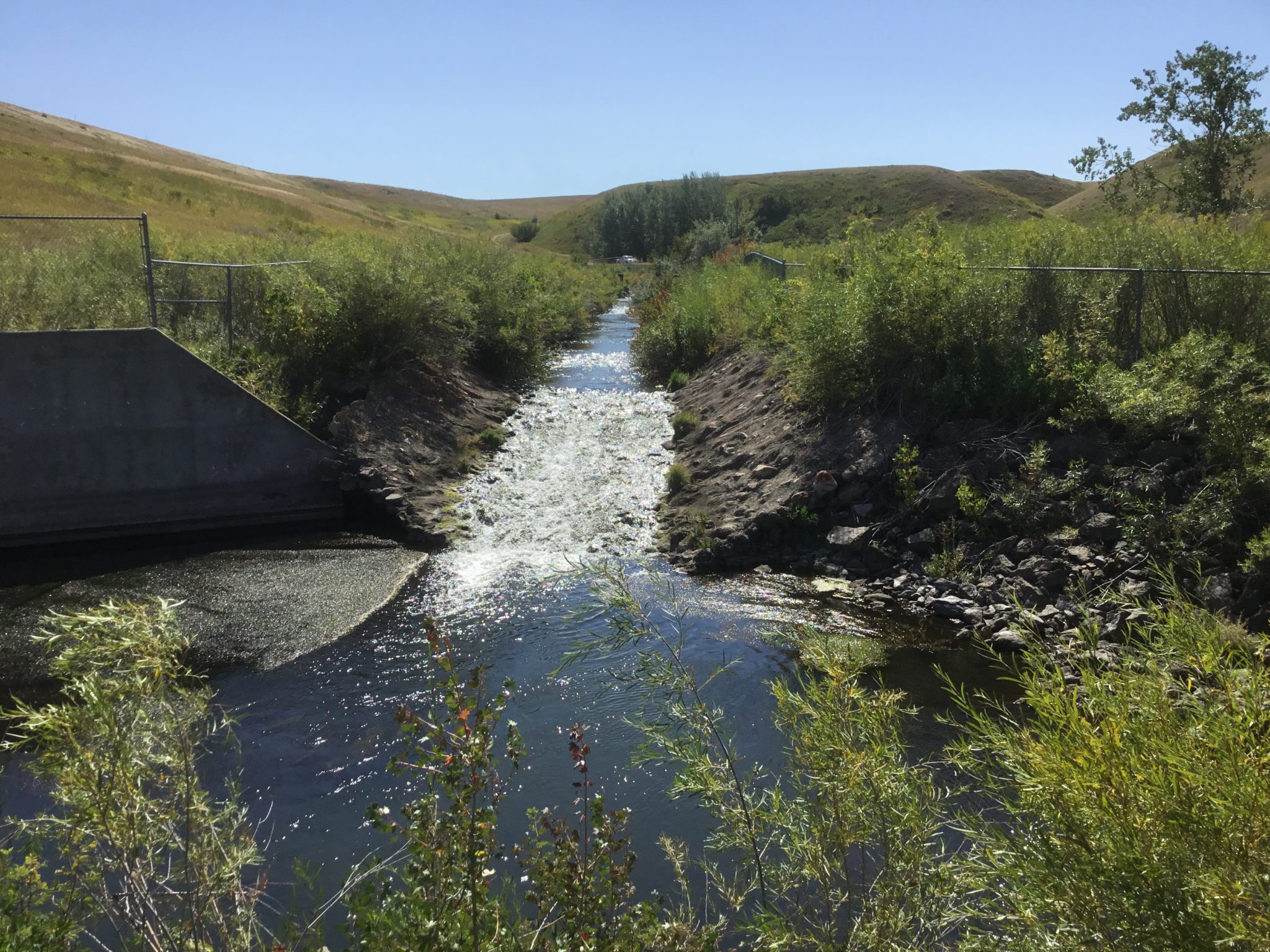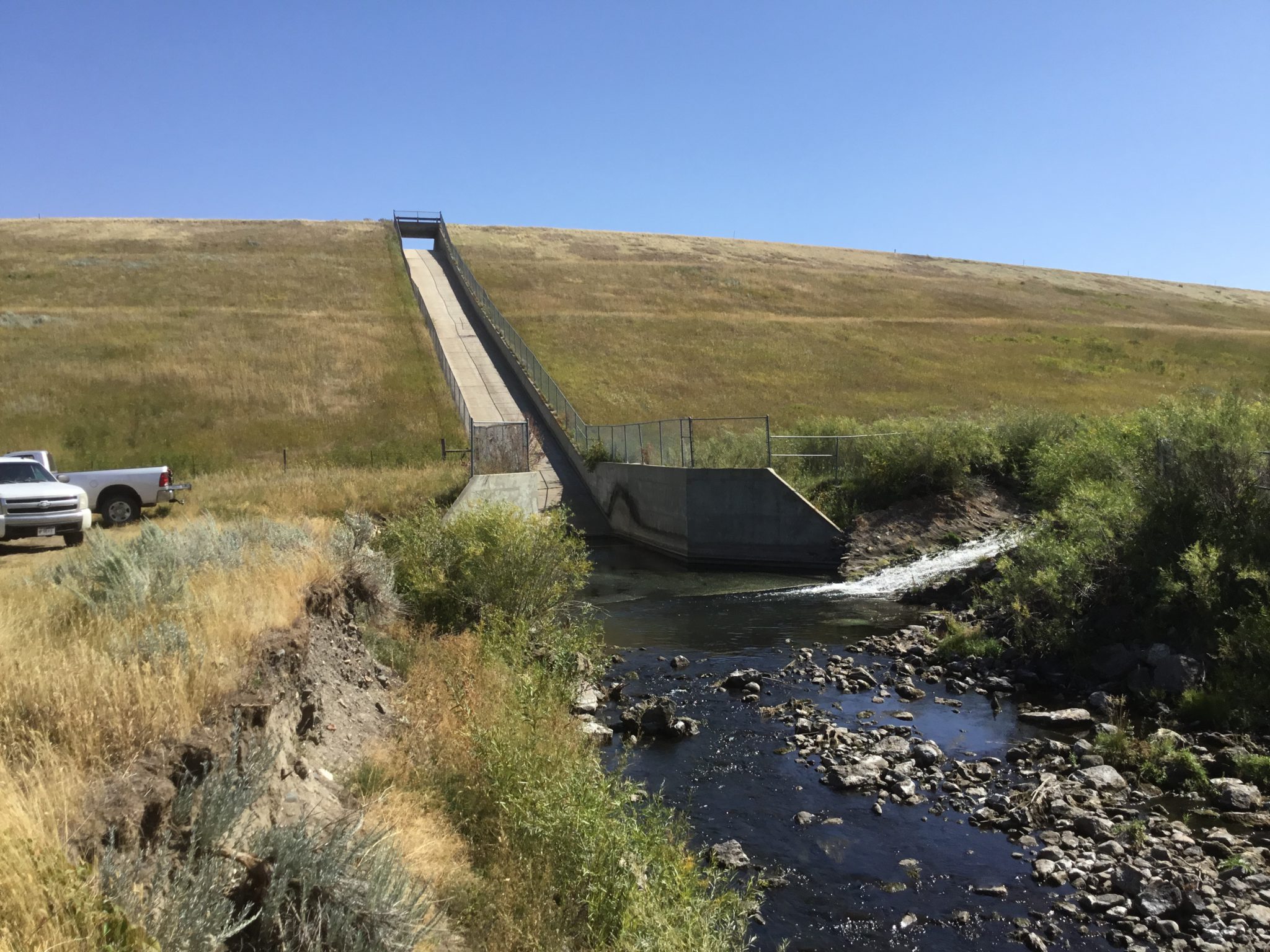Located approximately 10 miles south of Havre in Hill County, Beaver Creek Reservoir (also known as “First Lake”) is one of two reservoirs within Beaver Creek Park. The dam, constructed of earth fill, is over 100 feet tall and stores more than 6,000 acre-feet of water. Beaver Creek Park, owned by Hill County, is the largest County park by area in the United States and is a popular recreation destination in the Bear Paw Mountains. The park boasts several campgrounds, hiking trails, and picnic areas, with Beaver Creek, Beaver Creek Reservoir, and Bear Paw Lake being popular spots for anglers.
Beaver Creek provides irrigation water to agricultural users downstream of the dam and is part of a complex series of dams, levees, canals, and ditches that help protect the City of Havre and surrounding areas from seasonal flooding. Beaver Creek Dam helps dampen the effects of seasonal runoff in Beaver Creek from overwhelming other flood prevention infrastructure on the Milk River downstream.
In 2024, Beaver Creek Dam celebrated 50 years of service, which is relatively young considering that most dams were constructed in the 1940s and 50s. Though originally built and funded by the Natural Resources Conservation Service (NRCS) (formerly the Soil Conservation Service) in 1974, ownership, operations, and maintenance of the dam were transferred to Hill County immediately after construction.
Great West has served as Hill County’s on-call engineer for over two decades and began working on the Beaver Creek Dam in 2009 following a 5-year periodic inspection. Due to the age of the dam, many features had exceeded their useful life, and the inspection identified many critical action items necessary for the dam’s continued safe operation. Over the past 15 years, Great West has proactively addressed this extensive list of repair and rehabilitation items to ensure the dam’s safe operation and maintain compliance with the Dam Safety Operation Permit.

Map of Beaver Creek Park
A crucial part of this process has been applying for and receiving nearly 10 grants (combination of planning and project grants) from the Montana Department of Natural Resources and Conservation (DNRC) to aid the County in funding repairs and improvements. Without a sufficient funding mechanism to cover the significant operations and maintenance costs associated with owning a dam, obtaining grant funding has been vital.

Before – Pressure Chamber Rehabilitation and Slide Gate Replacement

After – Pressure Chamber Rehabilitation and Slide Gate Replacement

Before – Repair Spillway Plunge Pool

After – Repair Spillway Plunge Pool
Project work has included:
- Replacing irrigation outlet slide gates and repairing the concrete pressure chamber (2014).
New reinforced lid on concrete pressure chamber, new manhole access, new 10-inch and 30-inch slide gates, new gate operators, and site drainage improvements. - 5-year periodic inspection (2019).
Completed periodic inspection and updated O&M manual. - Repairing spillway plunge pool and miscellaneous concrete repairs on chute spillway (2020).
Remove eroded grouted riprap channel. Install new rock riprap in stilling basin plunge pool and irrigation outlet channel. Repair damaged concrete at the bottom of the chute spillway and the curb at the top of the chute spillway. - Repairing monitoring wells and air vent on 10-inch irrigation outlet (2022).
Many of the groundwater monitoring wells also serve as a seepage underdrain system. Several of the wells and valves had been damaged by vandalism, making it impossible to obtain accurate readings of the water pressures in the soil under the dam. This project replaced or repaired the damaged features to restore their proper operation. This project also repaired an air vent on the 10-inch irrigation outlet that had corroded and failed. - Installing new automated lake level and irrigation outflow gages (2022).
These new measurement devices allow real-time monitoring of the reservoir level, the inflow, and the irrigation outflow. Previously, the inflow and outflow had to be measured manually using Parshall flumes and staff gages, and the lake level had no measurement device. These pieces of information are crucial for the County to be able to balance the often competing purposes of the dam (i.e., flood protection, irrigation, fish and wildlife, and recreation). - Repair the tailwater channel downstream of the spillway plunge pool (scheduled fall 2024).
The channel has eroded and over-widened from its design condition. This creates an unpredictable hydraulic jump that has led to erosion in other areas. The project will install a concrete control section followed by a riprap apron to ensure the spillway performs as designed. Check out the video of the spillway flowing in the spring of 2024! - 5-year periodic inspection (schedule fall 2024).
Planned inspection to maintain compliance with the Montana Dam Safety Operation Permit.

New Automated Irrigation Outflow Gage

New Automated Lake Level Gage
The ongoing maintenance and rehabilitation efforts at Beaver Creek Dam underscore the importance of proactive management in ensuring the safety and functionality of vital infrastructure. These efforts not only protect the surrounding communities from the risks of seasonal flooding but also support recreational activities and agricultural irrigation that are essential to the local economy and way of life. As Beaver Creek Dam continues to serve Hill County, the collaborative efforts of the County, Great West, and the Montana Department of Natural Resources and Conservation highlight the critical need for sustained investment in infrastructure. Looking forward, the continued commitment to maintaining and improving the dam will ensure that it remains a cornerstone of the community for generations to come.
LATEST NEWS
Beyond the Blueprint: How GIS Enhances Engineering & Planning Solutions
Geographic Information Systems (GIS) have become an essential tool for communities striving to make smarter, data-driven decisions. From infrastructure planning to public engagement, GIS provides a dynamic way to visualize, analyze, and manage data across a wide range...
Yearly ROSE Award Winners
At Great West Engineering, we take pride in recognizing the dedication and hard work of our team. Each year, the Recognition of Special Effort (ROSE) award honors employees who go above and beyond—those who step up, make a difference, and inspire those around them....
Why Transportation Planning Matters
Transportation planning is the collaborative process of evaluating the current state of a transportation network at a local, state, or regional level, identifying future transportation needs, and outlining implementation and funding strategies to align with...



